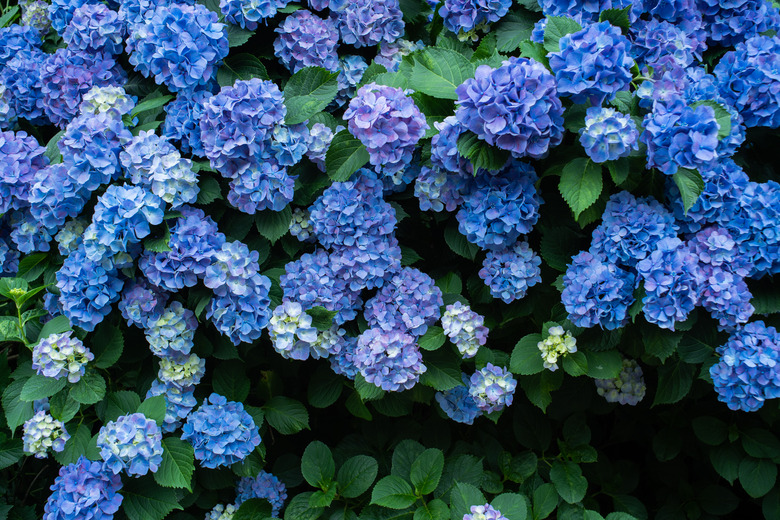How Often Should I Water My Hydrangeas?
We may receive a commission on purchases made from links.
Hydrangeas (Hydrangea spp.) are low-care garden shrubs, but they still have cultural needs that include ample irrigation. The definition of "ample" will vary depending on the species, the climate, the daytime temperatures, and the sun exposure. As a general rule, water enough so that the plants do not wilt.
Meet the Hydrangea
Meet the Hydrangea
Hydrangeas are easygoing shrubs, popular for their low-maintenance ways and their bright, beautiful blossoms. Each flower grouping includes showy male flowers and small, fertile female flowers. There are several different species of hydrangeas grown in the United States, but all of them have long bloom periods. With a proper mix, their flower display will light up the garden from early summer though the frosts of fall.
Bigleaf hydrangeas (Hydrangea macrophylla), with large, round flowers that can be pink or blue depending on the soil acidity, are the most popular species in the U.S. But they are not the only species, and each has its own charm.
Hydrangea species native to the U.S. include heat-tolerant smooth hydrangeas (Hydrangea arborescens) and cold-hardy oakleaf hydrangea (Hydrangea quercifolia). Their mature size varies considerably, with bigleafs topping out at about 6 feet tall and almost as wide, while the PeeGee, the popular panicle hydrangea cultivar (Hydrangea paniculata 'Grandiflora'), grows to the size of a small tree at up to 25 feet tall.
Grow Hydrangea Shrubs
Grow Hydrangea Shrubs
Each species of hydrangea has its own ideal growth requirements. For example, bigleaf prefers a site with some sun that also provides shade in the hot afternoons, while panicle hydrangea thrives in cooler zones (USDA zones 3 to 8) and prefers full sunshine. In general, all prefer moist, well-drained soil.
Pruning a hydrangea requires an understanding of the species' growth patterns. Some species flower on the prior year's growth, including bigleaf and oakleaf. They must be pruned immediately after their blooms are finished in late summer. Other species, like panicle and smooth hydrangea, set flowers on the current year's growth. Prune these in late winter.
Water Your Hydrangeas
Water Your Hydrangeas
The water needs of hydrangeas depend on the species, the site, the season, and sun exposure. That means there is no hard-and-fast rule about how many gallons of water to offer a hydrangea every week. The key is to provide sufficient water to prevent the shrub from wilting.
Practically, this means you'll have to water a few times a week during the growing season. Oakleaf needs less water than the other species, but it still must be watered every week. There is a decided relationship between sun exposure and the amount of water required. The more direct sun a plant gets, the faster the soil dries out. A hydrangea planted in full sun will only survive with extra irrigation.
But even a little water can be too much water depending on drainage. Hydrangeas need well-drained soil, and if you plant them in clay soil, for example, whatever water the plant receives stays around the roots, causing root rot. You can amend clay soil by working in organic compost material before planting.
Water the plants at ground level in the early morning to prevent the water from evaporating. Note that the shrubs go dormant in winter, and no water is required.
